 |
|
|

|
2007
July
31
|
End of month
I breathe a great sigh of relief because
my Google problem seems to be
clearing up; Google is starting to index this notebook correctly,
although not all recent months are covered yet.
Apart from that, as you can guess, I'm busy with other work
and will see you in August. The first entry of August may not
appear right away — I'm trying to get Google catch up.
Permanent link to this entry


|

|
2007
July
30
|
The joke was on me
The reason
that picture of a rose
was unprintable on my Epson R300 is that the nozzle for
one of the printer's six inks, dark cyan,
was completely clogged.
Dark cyan is the complement of red and is what the printer would use to
darken red or turn it into black.
With the nozzle cleaned, the picture printed acceptably, although I got a better
print by reducing the color saturation.
Permanent link to this entry


|

|
2007
July
29
|
A picture you can view but cannot print
See also the next entry (above).

Here you see a close-up of one of the roses that I gave Melody for our anniversary.
My attempts to make a print of this picture have been largely unsuccessful.
The reason? Too much red.
To be precise: The dominant color in this picture is very close to the red phosphor
used in your computer screen. Computer screens use RGB color; that is, they mix red,
green, and blue light.
But printers normally use CMYK color; they mix cyan, magenta, yellow, and black ink.
They can't produce an equally vivid red. My attempts to print the picture with my
Epson R300 came out with extremely high contrast and even posterization effects.
So enjoy it here, where you can see it!
Permanent link to this entry
Economic miscellany
Continuing to clean out the inbox, in the hope that Google will soon resume
indexing this blog properly...
Snowballing car loans: Ponzi scheme?
There's a rising tide of
people going bankrupt before age 25,
and one of the main culprits is
the practice of trading in a car for less than is owed on it,
rolling the difference into the loan for the next car.
Do that three or four times, and you can owe $80,000 on a $25,000 car.
Melody points out that this works almost like a pyramid scheme, but
without the expansion of the pyramid. Each lender is planning on his loan
being paid off by the next lender, not the borrower. So the borrower's
ability to pay is being ignored. Foolishness!
Investments: Still on the financial pages,
in my opinion
FRESX is no longer a good investment and I've gotten out of it.
I'm getting into
FSEAX and watching it carefully, since it may not always do this well,
and am considering
FWRLX as an alternative.
Should everybody have the same income?
I'm against poverty but not against inequality so long as no one suffers.
I don't believe the naive socialist doctrine that there's a finite amount of wealth to go
around, and the rich are taking it away from the poor.
No; wealth is produced, and if you stop the most highly productive people from
working (which is a popular leftist tactic), the whole country becomes poorer.
There's an interesting piece on this in
Mankiw's blog.
Right now, the rich are getting richer, and the poor are also getting richer, but
not quite as fast. Why the widening gap?
Many factors, but one of them is that education is more rewarded than it used to be,
and beyond that, some people work more than others.
People at the low end of the income scale actually have more free time than they used to.
But highly educated, professional people work a lot more than they did in the 1950s —
back when everybody talked about the value of hard work but the stores weren't open at night.
Note also the extremely long discussion following the article.
Permanent link to this entry


|

|
2007
July
28
|
Cleaning out the inbox...
A few short notes...
Sage advice for local historians:
Most of what I read about the history of Valdosta and its surroundings is
weak on geography. Locations are not given precisely, or are given
by saying "where X now stands" forgetting that X is not always going to be
there. Even street numbering systems change over the years.
I suspect this is a problem with local history generally. In this era
of GPS and online topo maps, every historical investigation should pin down
the geography and preserve it for posterity.
Those angle brackets:
It's true that you should put < > around URLs in e-mail
to keep them from being broken by word wrap.
Laura Halliday tells me it's
official, documented in
RFC 3986, Appendix C, "Delimiting a URI in Context."
And it works with quite a few mailreaders, if not all.
Windows applications with consoles:
A while back I wrote about compiling a .NET Windows app as a console app so you'll
have a console to write on.
Jim Mischel writes to remind me that .NET applications can perfectly well call
the Win32 AllocConsole function.
He has written three articles about consoles under .NET
(here,
here, and
here,
with source code
here).
About ASP and ASP.NET:
Yesterday I wrote about redirection via ASP scripting. Both ASP and ASP.NET are
Microsoft's methods of server-side scripting (analogous to PHP; they can also do
client-side scripting, which I've stayed out of).
ASP is the older technology and is better for smaller, simpler scripts.
Scripts are normally in VBSCRIPT or JSCRIPT and are
interpreted. The web page file name usually ends in .asp although servers
can be set up differently.
ASP.NET is newer. Scripts are compiled on demand, and the compiled code is cached.
This is better for larger, more complicated scripts. The scripts are written in C#,
Visual Basic, or other languages, and the source code can appear in the web page file
(like ASP) or in a separate "code-behind" file. File names normally end in .aspx.
Many people are not aware of this.
Of course, you can install Perl and PHP if you want to, and those will give you interoperability
with UNIX servers — but if you're sure you'll be using a Windows server, look at what it
already has built in. As a scripting language, you can't get anything more powerful than C#.
Congratulations to my graduate student Joe McFall, who finished his master's degree
last week and got a C# programming job within 2 days of going on the job market.
C# is hot property! Of course, the programmer's talent is also a factor...
Permanent link to this entry


|

|
2007
July
27
|
Uploaded early! Read tomorrow's news today!
META Refresh is deprecated
(and seems to be causing my Google problem)
As you know, I've been having problems with Google not indexing this notebook.
This link
should return two Google results, one in blog/0707/index.html
and the other in blog/0705/index.html.
As of right now it returns only blog/index.html.
Good news: As of July 29, parts of the blog are beginning
to be indexed correctly. Apparently the solution described below is the correct one.
It will take a few more days for Google to crawl the whole thing.
I have begun to find out why.
On my web site are several pages — notable among them michael/blog/index.html — whose
only function is to direct you to other pages.
They do this by using the
META Refresh keyword.
That is, they tell your browser to reload the page from a different address.
There are a couple of problems with META Refresh.
First, it wasn't actually designed to do redirection at all.
It was created as a feature of Netscape so that things like weather radar,
webcam images, etc., could be refreshed every few minutes.
Second, and more seriously, people have been using it to
trick search engines
and, for that matter, to trick unwitting humans.
Did you ever go to a web site and immediately get transferred to something utterly different,
such that your Back button wouldn't get you out of it?
That's done with META Refresh.
Accordingly, safe browsers will soon stop obeying META Refresh instructions, and more importantly,
Google has become reluctant to follow them.
That, apparently, is why Google has been indexing only the current month
of this notebook for the past few months.
What's the alternative to META Refresh? It depends on your server.
And that's my next topic, below.
Please note that I haven't proved that this is what Google's problem was.
It will be at least a few days before we know.
But there are other good reasons for me to make the change.
In the meantime,
if you have bookmarked www.covingtoninnovations.com/michael/blog you'll continue
to be redirected to the current Notebook each month.
If you've bookmarked that address with /index.html at the end, please take that
part out, because index.html no longer redirects automatically, at least at present.
Permanent link to this entry
How to do 301 redirection in Microsoft IIS 5.0
(without access to the server console)
In our last exciting episode I was telling you that the web address
www.covingtoninnovations.com/michael/blog
will continue to redirect you to
www.covingtoninnovations.com/michael/blog/0707/
(or 0708, and so forth, whatever is appropriate for the current month).
But I'm no longer using META Refresh. What am I doing instead?
I'm doing a "301 redirect." That is, I'm making the server give you HTTP return code 301,
which means the page has moved permanently to a new address. "Permanently" is relative, of course.
In the familiar world of Apache server software, I'd do a 301 redirect by
setting up an .htaccess file in the michael/blog folder.
But my server is running Microsoft IIS 5.0.
How did I find this out?
By using
this test page
to look at all the headers.
(All the useful stuff is at the bottom of their web page; the top is covered with ads.)
And normally, you configure redirection in IIS 5.0 from the server console.
I can't do that.
The server is in Michigan and I'm in Georgia.
So how do you do a 301 redirect? By means of ASP scripting.
In place of, or in addition to, index.html, I created a file called michael/blog/Default.asp
with the following content:
I'll update that file monthly so that going to michael/blog/ will always
redirect you to the right place.
If you go to michael/blog/index.html instead, you won't be
redirected automatically, but you'll get an explanation and a link to click on.
I'm new to ASP and others can doubtless shed more light on this.
Note, too, that you must have IIS configured to run .asp files in every
folder (which is a common setting but not the only one).
Permanent link to this entry


|

|
2007
July
26
|
Valdosta by air
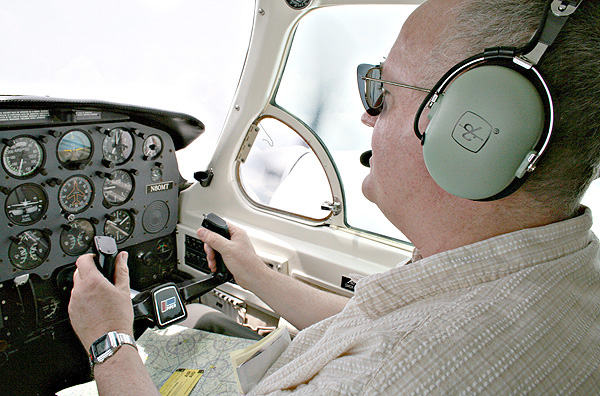
During the trip down, Brad let me fly the plane (a Piper Navajo) for a few minutes after he
had carefully adjusted everything so that it would fly level and straight of its own accord.
Accordingly, I had little to do, but it left me with an impression:
An airplane is the exact opposite of a mini-bike or go-cart.
Instead of darting around in an aerial vehicle, you just calibrate and adjust a precision
machine. At least, that's how I approached it. Keep the climb rate zero, make sure the
altitude is correct, keep the heading at 185 degrees... with just a slight nudge of the
controls whenever one of these is wrong.
That was in extremely calm weather, of course. I'm sure it would be much more like a go-cart
or mini-bike in a storm.
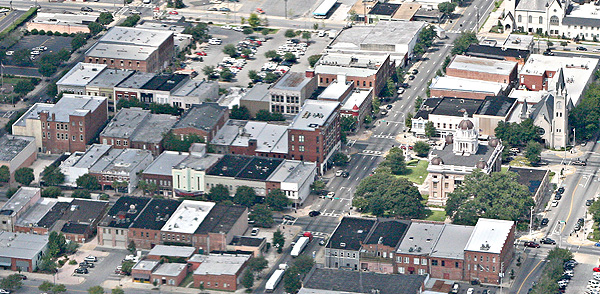
We got some pictures, although this plane's windows were irregular enough that the pictures
aren't critically sharp all over. Here you see downtown Valdosta from the air. You're over
Lee Street (roughly), looking west-southwest.
Permanent link to this entry
Against rebates?
Clark Howard has called for
an end to rebates as a marketing practice, and I'm inclined to
agree with him. Some merchants are doing away with rebates voluntarily,
but I'd like to see them abolished by regulation.
The problem is that
a surprising number of eligible buyers never get their rebates,
and there's increasing evidence that
this is by design, to keep from paying out money.
Not only that, but the rebate
may not be paid in real dollars.
At best, rebates are tricky — you often discover too
late that you've thrown away a crucial piece of packaging or missed
a deadline.
Rebates first appeared on the scene in 1978 when Lee Iacocca took over Chrysler
and had to reduce the prices of cars that were already in dealers' hands.
Now rebates are commonly used to market computer components and consumer electronics.
And instead of filling in a form at the point of purchase,
now you have to save the packaging, cut out the UPC label,
have an address that isn't a P.O. box, send everything off in time
for a specific postmark date, recite the serial
number backward by the light of the full moon... just kidding about that
last one, but that's what it's like.
I'd like to see rebates go away, at least from the customer's point of view.
Manufacturers could still make
rebates to the retailer upon proof of sale, while staying out of the
customer's hair. Thus, it would still be possible to lower the price of products
in the retailer's hands. But we wouldn't have to do the paperwork.
Permanent link to this entry


|

|
2007
July
25
To see this entry
on a page by itself,
click
here.
|
|
25 years!
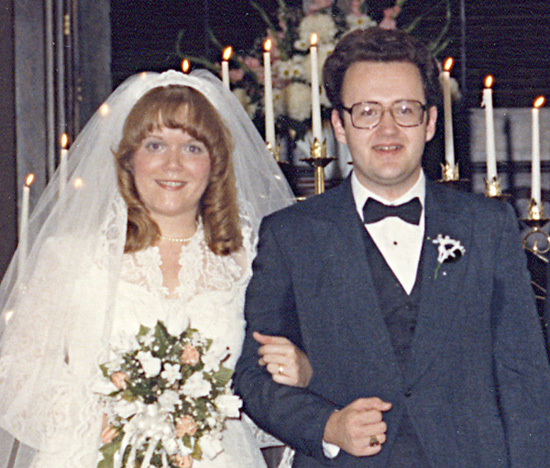
Today, July 25, 2007, Melody and I celebrate 25 years of happy and successful
marriage.
I do mean happy and successful.
We haven't had so much as one serious quarrel the whole time.
I've written some things already about why we've done so well.
To begin with, I think part of the secret of being happily married
is wanting to be,
and wanting it wholeheartedly.
You have to genuinely love each other — and that is act of the will,
a commitment,
not just something that passively happens to you.
You also have to want to be the kind of person who can be a good spouse —
and I don't mean a homemaking stereotype, female or male.
I mean a person who is genuinely dedicated to the other.
People say that to have a happy marriage, "you have to work at it."
I won't say that.
Being married to Melody is far too much
fun to be called work. But we definitely love each other so much that we are on
our guard against anything that would come between us.
One of the ground rules I set for myself, long ago, is that I would never keep
a list of grudges or grievances against Melody (or, for that matter, anyone
else; it's contrary to Christian morality; see
I Cor. 13:4-5).
Nor would I ever criticize her, to herself or to anyone else, nor allow anyone
else to criticize her in my presence.
Deeper than that, both of us believe in no cynicism.
We do not engage in the kind of soul-destroying mind games where a person tries both
to affirm something and to deny it.
We are wholehearted.
I don't insult myself by saying that my wife "ties me down" or "won't let me" do some dubious thing.
I married Melody voluntarily.
I made a commitment and I'm going to follow through with it.
Best of all, Melody and I are best friends.
Not all marriages have this characteristic; before the 1950s, probably, few did.
A man and a woman can certainly be lovers, and even happy spouses,
without being very deep friends,
without having many intellectual interests in common.
But in fact Melody and I are friends.
I thank God for these 25 years. 2500 more years would not be enough.
Other related entries:
How we met
The secrets of our happy marriage
|
Permanent link to this entry


|

|
2007
July
24
|
South Georgia
My cousin Tonita Branan and her husband Brad Brechtelsbauer treated us to a trip
to southern Georgia over the past four days. Quite literally, they flew us down
there in their airplane. I'll write more about this soon. We did have to spend some
time attending to family obligations, but for the most part, it was a vacation,
the first time in several years I've been able to spend 3 consecutive days not
working.
Soon I'll tell you more about the trip, including my first experience of flying an airplane myself,
and (oddly) having to speak German at the Lowndes County Historical Society.
(When Tonita tells people I can speak a foreign language, they believe her.)
I'm something of a Valdosta history buff, and one of the things I like
about South Georgia is that its history is so quirky. Lowndes County actually lost
(mislaid, couldn't find) its original county seat, Franklinville, which existed only for
a short time. Historians located it again, but I'm told the roads are out and you can't
get there now. Nothing like that would happen in North Georgia, which is a duller place.
We did some serious nature and landscape photography.
Below you see the Withlacoochee River from the Lowndes County Public Boat Ramp between
Clyattville and Nankin.
This is about as low as the river gets;
we're having a drought.
After a wet spell it can be 20 feet higher.
(To be precise, at the Hahira station, its level is currently 1.8 feet;
record low is 1.1, flood stage is 13.0, floods to 20 are not uncommon, and the
record high is 33. Aren't you glad someone keeps track of these things?)

In the 1850s, this river brought steamboats to Troupville; today it is full of fish,
some of which were actually jumping out of the water, and quite a few people were fishing
from the boat ramp area. We saw no boats, probably because of the low water level.
Permanent link to this entry


|

|
2007
July
21-23
|
A negative presupposes a positive
Why have tobacco companies been willing to pay for anti-smoking ads?
Perhaps because, as
my colleague Hye-Jin Paek recently determined,
the ads tend to backfire, at least on part of their audience.
When you say "Don't smoke" you get people interested in smoking.
Newspaper article (registration required)
here;
abstract of scholarly journal paper
here.
This follows from a basic principle of communication, pointed out, I think, by the linguist Talmy Givon:
a negative presupposes a positive.
You don't say "not X" unless there's some reason to believe X.
And if people hear "not X" and don't already believe X, they'll start thinking about
whether they should.
In particular, if you say "Don't smoke," you are indirectly saying, "There's some reason why people want to smoke,
and I don't want you to know what it is." That's exactly what a rebellious teenager is eager to latch onto.
A much better anti-smoking tactic is to point out that big business wants to get you addicted to something
that will harm you, just so they can make money.
That is, be very explicit about why people smoke, and show that it's a bad reason.
Permanent link to this entry
Hiatus
I'm taking a few days off from blogging in order to pursue other projects.
Don't worry, I'll be back before the month is over.
In the meantime, enjoy the web comic XKCD,
which bridges the gap between mathematics, computer programming, and romantic comedy.
And keep checking
whether Google indexes this notebook properly.
(This query should do more than just take you right back here!)
Maybe they'll get it right soon.
Permanent link to this entry


|

|
2007
July
20
|
How to make Vista go sane
I have reluctantly joined the ranks of people who recommend
turning off UAC in Windows Vista,
at least while installing older software.
UAC, or User Account Control, is responsible for all those pop-ups where you're
asked to give permission when a program wants to do something to your system.
That is a Very Good Idea and I wish I could keep it.
UAC also intercepts any per-user settings that your software tries to write
into Program Files, and caches them in a separate cache for each user.
That is also a Very Good Idea and allows some surprisingly out-of-date software
to run well under Vista — better, in fact, than under XP.
But the key idea of UAC runs deeper than that.
UAC introduces a distinction between being Administrator
(i.e., using an administrator account)
and exerting Administrator powers.
Your process has to be "elevated" to do the latter.
That's where those pop-ups come in.
Introducing that distinction is also a Very Good Idea.
It makes official something that UNIX users were doing unofficially with "su root"
all those years.
So what's the problem?
A really terrible misfeature.
When a .BAT file "elevates" in order to exert administrative powers,
it loses track of the directory that it's running in,
and instead runs in C:\Windows\System32.
That means it can no longer find the other files that are in the directory with it.
And when the purpose of your .BAT file is largely to copy files into place,
performing a few other Administrator-level operations along the way, you're up the
creek.
So this year's AI Lend-Out Disc — the CD of free software that we lend to
our students — will tell Vista users to disable UAC.
This is done in Control Panel, User Accounts.
As you know, freeware tends not to be very cognizant of the operating system,
and a good bit of what we give out has to be installed by .BAT files of our own devising
so that things will actually show up in appropriate places on the Start Menu.
For that purpose, we have a set of .BAT files that I've been revising since Windows 95 days.
Right now they're getting a major revision because students with Vista laptops are
starting to turn up, even though our lab won't go to Vista for about a year yet.
And that is what was driving me crazy today — those .BAT files were
locked in mortal combat with UAC, and UAC lost.
Permanent link to this entry
Short notes
I'm about to be busy with another project and won't be posting here
every day. Instead, go and read some more
old books on line, such as
The English
and American Mechanic (a workshop handbook from 1874),
or
Goodwin's Greek Grammar,
or
Thackeray's Book of Snobs.
Permanent link to this entry


|

|
2007
July
19
|
A treasure-trove of old books — free
|
If you like older books (up through the 1960s), and you can do 20- to 150-megabyte downloads,
then Internet Archive: Text Archive is for you.
It's the most useful thing I've come across since Wikipedia.
Numerous libraries have digitized their older books — whatever is not covered by copyright —
and put them on line.
If your taste runs to Victorian scientific books, you're particularly in luck.
They have
Chauvenet's Spherical and Practical Astronomy,
Lowell's Mars,
Gosse's Evenings at the Microscope,
Davis's Practical Microscopy...
They have
Nichols' Safe Methods of Business
(I have long been entertained by my great-grandfather's copy of this
information smorgasbord).
They have the early radio manuals of
Elmer Bucher,
whose name is probably the source of the slang term "Elmer" for "person who helps you get a ham license."
Of course, they have fiction and poetry as well as nonfiction.
And they have audio archives of old radio shows, interesting music, and nobody knows what else.
You will often find multiple copies of the same book, digitized at different resolutions
or in slightly different ways.
In general, these are graphical PDFs, not OCRed and not searchable.
This is the same outfit that hosts
the Wayback Machine,
an archive of web pages as they looked in the past.
To see how Covington Innovations looked in 1999,
click here.
|
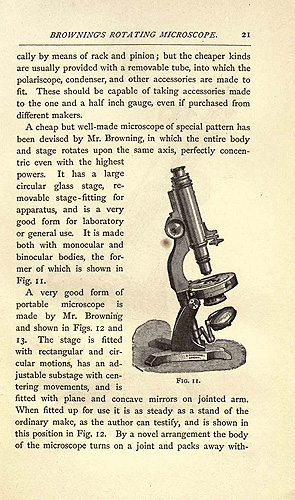
|
Permanent link to this entry


|

|
2007
July
18
|
Spines and scales

This rather pretty pattern resulted when a tiny aphid-like insect came in contact with a
piece of Scotch tape with which I was trying to catch it.
This whole arrangement of spines and scales is a total of about
0.2 mm long.
Specimen in a bubble of air under clear Scotch tape, Nikon S microscope, Plan 10x objective,
10x eyepiece, Nikon Coolpix 800, Photoshop.
Permanent link to this entry
Miscellany
Cleaning out the inbox...
The Guardian reports a
new vogue for vinyl phonograph records
because they are a tangible way to store music.
I think it's healthy that people are taking an interest in things made of matter
rather than software, although vinyl is actually
not a very good way to record music; even tape is better.
Marijuana makes you stupid and unattractive:
That's exactly the message this ad gets across to young people, and it's the right message.
For too long we've been telling them, "marijuana will get you excluded from boring adult society
of the kind you don't want to be in anyway." As Slate Magazine points out, much of what's
right about the new ad is the kind of details it doesn't include.
Best astrophoto I've seen recently:
International Space Station passing
across the face of the sun, by Jerry Lodriguss.
Read his narrative of how he took it.
Astrophotography is often like that.
Electro-optical toy of the day: the
EyeClops Bionic Eye,
a cheap video camera that "magnifies 200x." Surely that is not the linear magnification;
I'm guessing it's the area magnification, meaning the linear magnification is about 14x.
You can't stop me from suing you: In a decision that strikes me as
profoundly correct, the Supreme Court of Washington State
has invalidated
a contract clause in which customers promise never to bring a class action suit.
My question is, will other states do the same, and what about clauses that insist upon
arbitration rather than lawsuits? The way I see it, contracts should not be able to
routinely and effortlessly abolish part of the legal system that governs them.
Permanent link to this entry


|

|
2007
July
17
|
Demonstrating Google's incompleteness
To test whether Google has resumed indexing this notebook correctly, try the query
"Comet Lovejoy discovered with Canon DSLR"
(with quotes) in your favorite search engine, or click on one of the
following links:
Google,
Yahoo,
AltaVista,
Microsoft Live Search.
You should get a reference to my April 2007 Notebook. As it stands, today, Google does not
find this item but the other search engines do.
Permanent link to this entry


|

|
2007
July
16
|
Microfilming with a digital camera
|
The weekend's big project consisted of preserving a few hundred pages of
old family papers, some of them quite important and irreplaceable.
The question I faced was how to do this in a reasonable amount of time.
Using a scanner would be too slow, and many of the papers were wrinkled and might be
damaged by forcible flattening.
So I started thinking about how we microfilmed
medieval manuscripts back when I was studying them in the 1970s and 1980s.
You could do it with a 35-mm camera and suitable film;
just focus and photograph the pages one by one.
A quick experiment showed that a 10-megapixel DSLR would do the job;
in fact, about 4 megapixels would probably suffice. Here's the procedure:
- Set up an easel with a board on it, lights, and the camera on a tripod.
- Position the camera so that half of an old-style newspaper page fills the field.
(This is the largest size
document that I needed to photograph.)
-
Set the lens to f/8 for depth of field (so wrinkled documents will be readable) and use aperture-
priority autoexposure and autofocus.
- Set the camera for medium-quality, highly-compressed images, and verify that a newspaper is
legible when photographed this way.
- Put the documents on the easel one by one
and snap away. Even if a document doesn't fill the field, don't bother
moving the camera. The blank background takes up very little disk space after JPEG compression.
The plan is that someone else can do Photoshop work and crop and adjust the pictures later, when
they are needed. The goal for right now is preservation.
As you can see from this newspaper clipping, the technique works beautifully.
This is cropped from a picture that covers half of a newspaper page
(about a 16×24-inch field of view).
I used a Canon 50/1.8 normal lens; a cheap zoom lens might not have done quite so well.
In all, I took about 500 pictures and burned them to a single CD.
|
|
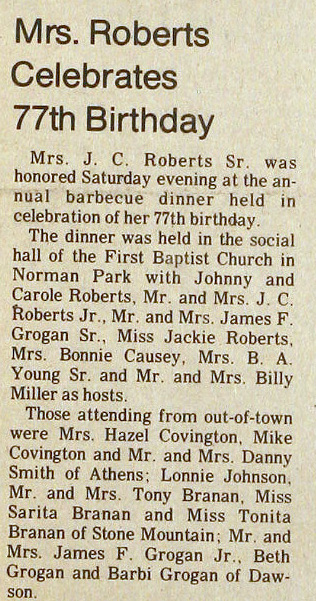
The Moultrie Observer,
August, 1981
|
Permanent link to this entry
Epithelial cells


In the process of learning how to take pictures through a microscope I decided to do a
familiar
freshman biology lab exercise.
I scraped the inside of my cheek with a toothpick,
pressed the end of the toothpick onto a microscope slide,
let the smeared material dry,
"fixed" it by passing the slide through a flame a few times,
applied a drop of gentian violet dye diluted in water,
let it soak in for a couple of minutes,
washed it off with isopropyl alcohol,
let the slide dry, and took pictures.
At the top you see the slide as soon as it dried, with no cover slip.
Nikon S microscope, Köhler illumination, 40x Fl Plan objective,
10x eyepiece, Nikon Coolpix 990 camera, image adjusted and sharpened with Photoshop.
The second picture was taken the next day, after a cover slip had been cemented on
with Cytoseal 60 (a material very similar to clear model airplane glue, which would
surely substitute for it). The camera this time was a Coolpix 800 and the image processing
was rather different, especially as regards color.
The slide didn't really change color between sessions.
What you see are epithelial cells and bacteria.
Epithelium is the red skin that we have on the inside of our bodies, including our
mouths; the cells are shed and regrown rapidly.
In each cell you can see the nucleus and some internal structure.
Clinging to the cells are thousands of tiny bacteria. These are harmless and are
normally present in the human body. In fact the big challenge of medical microbiology,
according to what I've read, is not to find bacteria; they're everywhere.
It's to show that a particular kind is or is not present in a particular place.
Notice that the wrinkled surface of each dried cell has lost contrast in the second picture,
where the cells are surrounded by liquid plastic rather than air. We rely more on the dye to
bring out details.
Permanent link to this entry
Still Google-less
Google still isn't indexing this Notebook properly, the way it did until March.
The trouble is that it indexes the redirection page
(michael/blog/index.html), which it sees as a page with
frequently changing content, rather than following the link
to the actual notebook page (in this case michael/blog/0707/index.html).
Putting a meta tag in the redirection page didn't help.
I'm trying a ROBOTS.TXT file next.
If I can just keep Google from seeing the redirection page,
it will find the actual Notebook pages through another set of links
(those on michael/blog/Previous.html).
Permanent link to this entry


|

|
2007
July
15
|
More vintage aviation
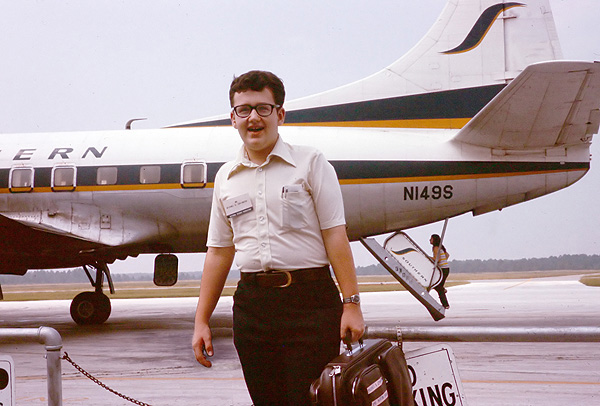
Here you see me at age 15 in my last minutes of being a resident of Valdosta, Georgia, in August, 1973.
The airplane took me to Atlanta, and I proceeded to San Francisco, met the rest of the
U. S.
President's Australian Science Scholars, and visited Hawaii, Australia, Thailand,
India, and Italy. We returned via New York, and eventually another aircraft of the same type
delivered me to my new home town, Athens, Georgia.
This picture was expertly retouched by Melody to remove a partially hidden person
who seemed to be attached to my right arm.
The airplane is a 1952 Martin 404.
Amazingly, this plane can still be located, and it apparently still flies.
It's at the
Mid-Atlantic Air Museum
in Reading, Pennsylvania.
The museum has restored its original Eastern Airlines paint scheme.
Permanent link to this entry


|

|
2007
July
14
|
Mid-20th-century aviation
Remembering Southern Airways

This picture, which I found on the
Southern Airways ex-employees' site
with no copyright indication, combines several of my early
memories of aviation.
You see a Southern Airways Douglas DC-3,
the kind of airplane in which
I made my first flight, as a 3- or 4-year-old, in 1961.
You see the great blue citadel of the old
Atlanta airport, which was
built in 1957 and torn down in the early 1980s.
(The old airport was built like Heathrow, with a central building and
corridors radiating in all directions.)
And you see Gate 26A, which was Southern's most-used gate, and through
which I passed many times. Curiously, Gate 26A and a small stretch of corridor
remained standing as a separate
building for a couple of years after the rest of the old airport was torn down.
That first flight actually did not involve Atlanta.
Southern had a route from Atlanta to Columbus (Ga.), then Moultrie-Thomasville, then Valdosta.
We lived in Columbus at the time, and my father took me with him to Moultrie,
where my aunt picked me up while my father continued to Valdosta on a business trip,
and my mother and baby sister soon arrived in Moultrie by car.
Later, I made a lot of flights from Valdosta
to Atlanta on the same route, but by then, they were
using Martin 404 aircraft like this (picture from same source):

It was in a Martin 404 that I departed Valdosta in August 1973
for a trip around the world,
and in a Martin 404 that I reached Athens, my new home, a month later.
Click here to see a
herd of them in their native habitat.
Until the 1980s, Georgia didn't have a full set of freeways, and that fact, combined with
federal airfare regulation, made it convenient to take shuttle flights to the Atlanta airport
rather than drive there or ride in a van. I seem to recall that in the days of regulated fares,
an Athens-Atlanta-New York trip
consisting of two flights
was cheaper than a single Atlanta-New York flight because it was a shorter distance.
The 75-mile hop from Athens to Atlanta was more convenient and safer than driving there —
and I hope that with the next shakeup in Athens' subsidized local airline service, they'll bring it back.
Planespotting:
I have no idea if the particular airplanes in the pictures are ones I flew on.
But do they still exist?
The aircraft numbers in the pictures aren't perfectly legible,
but if the DC-3 is N85SA, then according to the
FAA database
and
DC-3 census,
supported by
Southern's list,
it's presently in Fremont, Ohio.
The number on the Martin 404 is even harder to read,
but if it's N141S,
which is the only number in
Southern's list
that seems to fit,
then the planespotters
are onto it
(click for more pictures and information).
But the number N141S has been recycled by the FAA.
Permanent link to this entry


|

|
2007
July
13
|
Look elsewhere...
Instead of writing a Notebook entry today,
I updated
this
and especially
this.
Permanent link to this entry


|

|
2007
July
12
|
Funhouse mirrors in the dressing room?
WAGA-TV in Atlanta has done an exposé of something I'd never thought of.
Some clothing stores have dressing-room mirrors that are
bent to make you look thinner.
They advise you to press the mirror in the center.
If it's flexible, there may well be trickery going on.
Even a quarter inch of bending will do it.
Permanent link to this entry
Miscellany
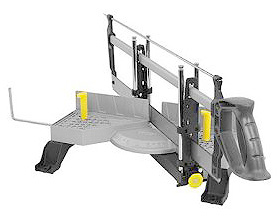 I am proud to report that the
Stanley 20-800 clamping miter box
accepts not only its own 558-mm (22-inch) blades, but also the
full line of Jorgensen 550-mm blades.
We are using this in the AI Lab to cut aluminum bars for building
frameworks for robots.
The Jorgensen blades are suitable for cutting metal, even steel.
I am proud to report that the
Stanley 20-800 clamping miter box
accepts not only its own 558-mm (22-inch) blades, but also the
full line of Jorgensen 550-mm blades.
We are using this in the AI Lab to cut aluminum bars for building
frameworks for robots.
The Jorgensen blades are suitable for cutting metal, even steel.
I've learned that my
entry about a Russian Geiger counter
is famous on the Web, so I added to it a copy of the translated instruction sheet
that started the whole thing. Follow the link if you need the instructions to a
Kvarts DRSB-01.
I'm still waiting for Google to re-crawl my web site so I can see if it's doing it
correctly. Until that's established, my notebook entries may be a bit bland.
Permanent link to this entry


|

|
2007
July
11
|
Miscellany
Clear Sky Clock, a Canadian service
that provides astronomy weather forecasts for hundreds of locations, has been
threatened with a lawsuit
over alleged trademark infringement.
Apparently, the problem has been worked out now, but I'm sad it happened at all.
There are unconfirmed reports that the lawsuit came from
SkyClock.
If so, the tradenames are different, the products are different, and the term "Sky Clock"
has been around at least since H. A. Rey's book The Stars (1962), and probably
centuries longer — so the suit was groundless from the very beginning.
Neuroscientists and statisticians are reporting that the
sharp rise in violent crime in the 1970s, and the drop in the 1990s, are
related to
lead poisoning
of children 20 years earlier.
Leaded gasoline came into use in the 1950s, putting lead fumes into city air.
Lead paint was also a particular problem then, as old paint started chipping away
and getting where it shouldn't. The urban poor were hit hardest because they were most
likely to breathe car exhaust all day and to live in deteriorating, lead-painted surroundings.
What's more, other countries have had rises and falls in crime at different times
corresponding to their use or non-use of lead.
For example, Britain's crime wave in the 1990s corresponded to
the proliferation of cars (with leaded fuel) in the 1970s.
Our old friend the Rev. Doug Beyer has preached an
excellent sermon titled,
What God has
taught me in 50 years of marriage.
Doug preaches nice, concise sermons. Read and be edified.
Melody and I are coming up on our 25th anniversary this summer. I don't know how elaborately
we'll celebrate it, but we've certainly had a good 25 years — and 2500 more would not be enough!
Permanent link to this entry


|

|
2007
July
10
|
The video résumé — a really bad idea
The Atlanta newspaper
is telling us that the latest fad in the business world
is to use a video recording as a résumé when applying for a job.
Really bad idea. The word résumé is French for "summary,"
not "long-winded sales pitch." It is designed to be scanned quickly.
It is not meant to demand a fixed time commitment.
As I've said before,
a striking advantage of written communication is that it can
be skimmed. When I read, I manage my time. When I watch TV, someone else manages
my time. That's why I don't like TV.
The video résumé might have a role as a supplement to a
conventional paper one, especially if the candidate needs to show off his or her
public speaking talent.
A supplement, not a substitute.
Also, given the way "the wired generation" likes to ham it up,
video résumés might turn out to be a great opportunity for people to
reveal things about themselves
that actually show why they shouldn't be hired.
Permanent link to this entry
Stupid phone tricks
Cathy got a call from "Cardholder Services" today. (Caller-ID blocked, of course.)
"Which card is this for?" she asked, and they hung up on her.
Clearly, it was a thief, about to ask her for a credit card number on some pretext.
Permanent link to this entry


|

|
2007
July
9
|
A surfeit of stars
Canon EOS 20Da farewell cruise
On the evening of July 4, I took the
Canon EOS 20Da on a "farewell cruise" prior to
returning it to Canon USA. The weather was rather hazy, but out in the country, I managed
to get some fairly decent pictures.
Here's the rich star field of Gamma Cygni, including some red nebulae.
My first act as an amateur astronomer, in October 1967, was to look at these stars
with my grandfather's 7x35 binoculars. At the time I didn't know the constellations,
but I've identified the star field later, and it remains one of my favorite parts
of the sky.
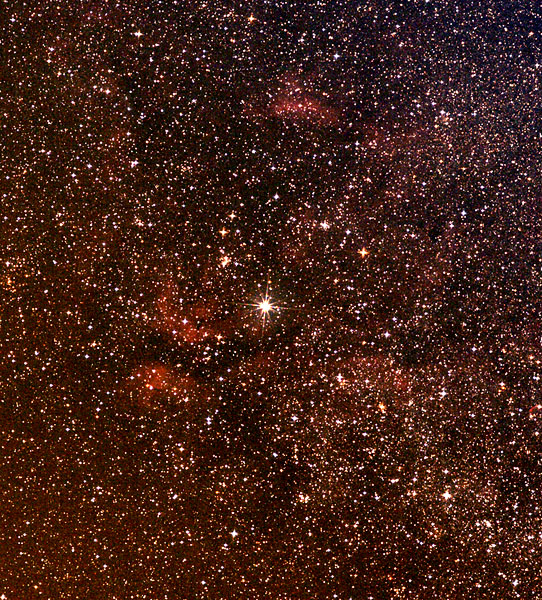
That's a stack of four 3-minute exposures through a 105-mm lens at f/4.5.
Next, two views of M8 (the Lagoon Nebula), with 105-mm and 300-mm lenses respectively
(the latter cropped to show just the central area of the picture).
This nebula is in the direction of the center of our galaxy, which is why you see
such clouds of stars below (south of) it.
Compare also the picture
here.
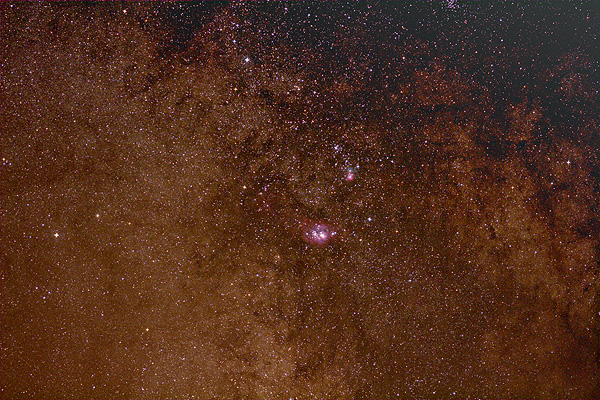

Permanent link to this entry


|

|
2007
July
8
|
Google doesn't see everything it ought to
I've just discovered that Google hasn't been indexing this notebook since about March 1.
That's why, the other day, I
thought I'd already written about a topic
but couldn't find my earlier remarks.
I think the problem is my redirection system.
Recall that most people come to this notebook via
http://www.covingtoninnovations.com/michael/blog/index.html
(underlined part optional),
which redirects to a different place every month, namely
http://www.covingtoninnovations.com/michael/blog/XXXX/index.html
where XXXX is a code for the month and year.
Google has recently tweaked its software for avoiding duplicate indexing
(since many web pages are now accessible more than one way), and
I'm guessing that Google was indexing only the redirection
address, not the permanent one.
It thought my whole Notebook was one page whose contents changed frequently.
To fix that, I've added the line
<meta name="robots" content="noindex,follow">
to the redirection page. That means: Don't index this page, but do follow the links on it.
It will take a few days for any of this to take effect, since Google doesn't crawl every day.
Time will tell. I may end up with a different naming scheme or something.
While troubleshooting,
I learned that, even without opening a Google account, I can find out what pages Google has indexed
by submitting a query like:
site:www.covingtoninnovations.com/michael/blog/0703
which will retrieve all indexed pages in that folder. That's how I know Google isn't seeing
0703/index.html when it should.
Until now I thought search-engine submission was bunk. It's Google's job to find my stuff.
Why Google isn't doing it, I'm still not entirely sure.
Then there are all those other search engines...
Permanent link to this entry


|

|
2007
July
7
|
Is 07-07-07 your lucky day?
Uploaded early. Read tomorrow's news today!
Be prepared for gamblers who consider 7 a lucky number
to do foolish things today because the date is 07-07-07.
My question for them is this: If 07-07-07 is everybody's
lucky day, then where will the money come from for your winnings?
The number 7 may have mystical significance to human beings because
it is close to the largest number that our minds can process without
counting or subdividing into smaller groups.
See
Miller's famous 1956 paper.
Permanent link to this entry


|

|
2007
July
6
|
How to get sharp pictures
Now that we all have cameras that autofocus and autoexpose perfectly,
why do so many people still get blurry pictures?
Spurred by a recent conversation with a friend,
in this entry I want to give a brief
troubleshooting guide.
Please pardon me for being excessively basic; I've found that to many otherwise
technologically literate people, a camera is just a magic box, and they don't
know what goes on inside it.
What is focus? Focusing a camera means moving the lens in or out, changing
its distance from the image sensor, so that it forms sharp images of objects
at one specific distance. You cannot focus on more than one distance at the
same time. That's a basic law of optics which you can't get around (although you
can make compromises). The camera always focuses at a specific distance.
Is focus the only thing that affects image sharpness? No.
A perfectly focused image can be blurred by camera shake from using an
excessively slow shutter speed (keeping the shutter open too long).
Camera shake looks like this:

Perfect focus, camera shake
(slow shutter speed, no tripod or camera support)
Also, the lens opening (f-stop) affects whether the lens can approximately
focus more than one distance at the same time. This property is called depth of field.
Here's an example:

Taken at f/2.8

Taken at f/13
Notice that you don't always want more depth of field; this particular picture
looks cluttered when the background is not completely out of focus.
Finally, the best autofocus system will go wrong if it focuses on the wrong thing:

Focused on wrong object (fence in background rather than flower)
So what can you do about all of this?
 First, know what your camera is focusing on.
It will usually tell you, with a beep and/or a light, when it focuses.
If your camera is a DSLR, you can watch it focus — provided your eyepiece diopter
is properly set. The eyepiece diopter is a little knob or lever right next to the eyepiece.
Adjust it so that you can see clearly when you look into the viewfinder.
First, know what your camera is focusing on.
It will usually tell you, with a beep and/or a light, when it focuses.
If your camera is a DSLR, you can watch it focus — provided your eyepiece diopter
is properly set. The eyepiece diopter is a little knob or lever right next to the eyepiece.
Adjust it so that you can see clearly when you look into the viewfinder.
If your camera wants to focus on the wrong thing, here's a trick: aim it straight at the
desired object, press the button halfway down so the camera will focus,
and then, holding the button halfway down, aim it to compose the picture the way you
want it. It will hold its focus settting until you press the button the rest of the
way to take the picture.
 Second, be aware of the shutter speed.
This needs to be 1/60 second or shorter for general snapshots;
1/125 if you're slightly shaky; and 1/500 in extreme telephoto or zoom situations.
The shutter speed normally shows up as a number (60, 125, or 500 respectively);
higher is faster.
Note that it can't be very high in dim light or with a small lens opening.
That's why sports photographers pay thousands of dollars to get an f/2.8 telephoto lens
instead of f/5.6.
Second, be aware of the shutter speed.
This needs to be 1/60 second or shorter for general snapshots;
1/125 if you're slightly shaky; and 1/500 in extreme telephoto or zoom situations.
The shutter speed normally shows up as a number (60, 125, or 500 respectively);
higher is faster.
Note that it can't be very high in dim light or with a small lens opening.
That's why sports photographers pay thousands of dollars to get an f/2.8 telephoto lens
instead of f/5.6.
If the light level doesn't permit a fast shutter speed, brace your camera
by holding it against a wall or any stable object — even if you don't hold it
very tight — or using a tripod.
And, just as when firing a gun, squeeze, don't jab the button. Be gentle!
 Third, remember that more light helps, and so does a higher ISO setting.
More light will give you a faster shutter speed and a smaller lens opening,
resulting in more depth of field. So will setting the camera to ISO 800 or 1600.
Third, remember that more light helps, and so does a higher ISO setting.
More light will give you a faster shutter speed and a smaller lens opening,
resulting in more depth of field. So will setting the camera to ISO 800 or 1600.
The ISO setting on a camera adjusts its sensitivity to light.
Unlike film, with digital cameras lower is not necessarily better.
Current digital cameras work best at ISO 400 to 800.
At lower settings, you're actually throwing away part of the signal
(which may be necessary in very bright light).
Higher up, at ISO 1600 or 3200, you may get a slightly grainy picture,
but it's a lot better than no picture at all.
 Fourth, learn how to use your camera's manual controls.
There are generally four modes:
Fourth, learn how to use your camera's manual controls.
There are generally four modes:
- P (camera chooses both shutter speed and lens opening);
- Av (A) (you choose lens opening and camera chooses shutter speed);
- Tv (S) (you choose shutter speed and camera chooses lens opening);
- M (you choose both)
.
For example, if you're taking close-ups and using a tripod, the shutter speed
doesn't matter but you want a small (high-numbered) lens opening, so you'd
probably use mode Av (A) and set f/16 or f/22.
If you're shooting sports, you may want to use Tv (S) and set 1/500 second
to stop the action (if the light level permits).
(Canon DSLRs also have a mode called A-DEP which is like P but tries to give you
more depth of field. It actually measures the distance of several different points
in the picture and tries to give you a lens opening that will make them all sharp.)
 Fifth, use digital sharpening judiciously. If you have a sharp picture,
you can bring out fine detail with the "Sharpen" filter in Photoshop or similar
software. Here's an example:
Fifth, use digital sharpening judiciously. If you have a sharp picture,
you can bring out fine detail with the "Sharpen" filter in Photoshop or similar
software. Here's an example:

Original

Digitally sharpened
But digital sharpening will not fix a blurry picture.
The question of how to deconvolve (unblur) a blurred picture is one of the hot
research areas of applied mathematics today. Perfection is not going to be possible;
you can't make the picture reveal things that aren't in it.
Permanent link to this entry
A couple more digital photography don'ts
(1)
Never use flash when it is not actually the best light source for your purpose.
In my opinion, flash is rarely the best way to take a picture.
It is certainly not — as some clueless newbies think — a necessary
magic ritual for using a camera.
It's simply a temporary source of light — a very harsh one.
And the flash on your camera definitely won't illuminate the other side of the stadium.
So don't let it try. Turn it off when it's not specifically wanted.
With a DSLR, this is as simple as setting the camera to P
(rather than one of the picture icons) and not popping up the flash
when you don't want it.
(2) Never change the height and width of a picture separately. Instead, trim
the picture to the desired size.
Here's an example.
The picture of me at the top of this column is 121×176 pixels:
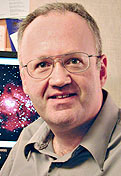
Suppose you need it to be 121×150. The right thing to do is to trim away
part of the original picture like this:
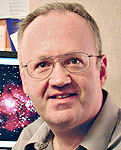
But there are people who will just resize the whole picture in one dimension without
the other:
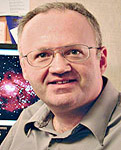
Not so flattering, is it?
Permanent link to this entry


|

|
2007
July
5
|
Does an alarm clock need 12 buttons?
Microprocessors have had a pernicious effect on all types of electronic home appliances.
They've resulted in needless complexity.
When you're programming a microprocessor, it's easy to add
a lot of functions, none of which corresponds exactly to anything the user
wanted to do.
Thus alarm clocks now have 12 or 16 buttons merely because they can.
And of course the buttons are labeled in 4-point black type embossed
on a black background, legible only with a slit-lamp microscope.
Meanwhile, simple operations, such as setting the time backward slowly, are still
likely to be missing. Remember the generation of digital clocks that could only be
set forward, so in order to go from 7:02 a.m. to 7:00 a.m. you had to cycle around
23 hours and 58 minutes?
This is just bad design. They're building what's easy for them to program, not what
the customer wants.
Or they've been misled by the fact that
adding "features" doesn't require adding parts, just more programming.
In some cases they've lost all sight of what it's like to be
the customer.
It's like 1980s word processing software.
Remember the Word Perfect keyboard chart?
One PC World writer summed up the situation something
like this: "Now just hold down Ctrl and the right-hand Alt key, press the period key 3 times
and then the comma, and bingo, your superscript is underlined!"
Thank goodness MacOS and then Windows delivered us from that.
Now somebody needs to do the same for alarm clocks, coffee makers, and the like.
I particularly dislike serial button-pressing. "Push this button 3 times within 2 seconds
to activate function X, then 2 times to get to menu Y..." What do they think I am, a man or
a serial UART?
(And why does my TV set require me to use 2 buttons and go through a menu to turn
closed captions on and off? I have to do this every time I want to view the cable TV schedule,
which is thoughtfully provided by the cable company
with captions right in front of the text.)
My other pet peeve is needless beeping.
It's easy to make beeping sounds with a microprocessor.
That doesn't mean it's a good idea.
Melody has an e-stim (electrical muscle stimulation) device that beeps every time you press
any of its buttons. You set it up by pressing "up" or "down" arrows repeatedly. That means
that at the beginning of every treatment session you have to endure about 300 loud beeps!
What it really needs is a rotating knob (like a car-radio volume control) and no beeper.
The only thing worse is the machine in the University of Georgia Science Library into which we deposit
money for credit toward Xeroxing. Every time you press a button, a loud BEEEEEEEEP!!
resonates across the library and disturbs everyone. I'll bet that if I made the same noise with a flute
or whistle or something, they'd kick me out.
Permanent link to this entry
Bad banking hurts everybody
The
subprime-lending mess
has now
lowered the value of the dollar
on international currency markets.
That means imported goods are going to be more expensive
— including, sadly, my books, which are printed in England —
and our overall cost of living is going up.
Permanent link to this entry


|

|
2007
July
4
(Extra)
|
Malware of the day: Drivecleaner ad / ErrorProtector ad
(I am posting this entry between July 4 and July 5 in order to provide
information about an apparent security hazard.
It will be updated as the situation becomes clearer.)
The other night I was looking up a name and address on
www.whitepages.com,
which is normally a very trustworthy online phonebook,
and instead of the data I requested, I got this on my screen:

You're viewing it slightly reduced here; in real life it looked exactly like
a Windows message box.
Text, for search engines:
"NOTICE: Your computer has tracks of all the adult sites you had visited. In most cases, you are
not even aware of the files that get installed by themselves , violate your online privacy and could
compromise your career or your marriage. These files leave tracks of your online behavior and even
compromise your credit card's security. It is possible to clean up all the temporary and history
records of your computer to remove these tracks. Would you like to install DriveCleaner to check
your computer for free? (Recommended)"
Note that it's written in rather bad English.
Further, it managed to hang Internet Explorer so I couldn't close the window
or navigate away from it. IE showed a link open to "www.drivecleaner.com" (which is
a real product,
apparently exactly what it was advertising)
with some kind of "cachebuster" application open.
Whoa there. I'm not going to be intimidated.
I don't view "adult sites" on this or any other computer.
I don't have anything cached here that would be damaging if made public.
And no, I'm not going to click on its "Cancel" button.
The message box is fake and we don't know what the Cancel button, or
anything else on it, actually does. Instead, I used Task Manager to close Internet Explorer.
Now then. Why didn't Whitepages give me the data I asked for?
Is this piece of malware a paid ad on Whitepages? I fear that it is.
I'm annoyed at Internet Explorer for not giving me a way to cancel its script.
I'm going to complain to Whitepages' management. I'm also going to run a virus scan.
Updated July 7, 7 p.m. EDT
Ongoing investigation:
Brook Monroe has traced the problem to ActiveX controls loaded by a script
actuated by an ad on Whitepages.com (which carries many ads for different companies).
There are unconfirmed reports that,
in turn, the specific culprit is a Flash ad for Weight Watchers which was hacked by an
unknown third party (not necessarily Drivecleaner).
The management of Whitepages has been cooperative. We don't know if Drivecleaner
is actually involved at all, though their product does have a reputation as a pest.
It all goes to show that web pages should not be allowed to run software, period.
ActiveX on the Web was a really bad idea.
Incidentally, in my case Internet Explorer 7
was already set to prompt before downloading signed ActiveX
controls, and to refuse to download unsigned ones altogether.
Updated July 15
After apparently being cleaned up, the problem is back, this time advertising
something called ErrorProtector instead of Drivecleaner.
At this point, sadly, I must advise people not to use Whitepages.com.
A competitor that seems to be free of the problem is Anywho.com.
Speaking of security hazards,
those "electronic greeting cards" are fake.
The recent flurry of messages about online greeting cards are actually viruses.
I am not going to click on a link or file that is supposed to be
a greeting card. Anyone who wants to send me a greeting card, please use paper.
Permanent link to this entry


|

|
2007
July
4
|
Who wants to be a video-game designer?
In the 30 minutes that I had the TV on just now, while doing my daily treadmill exercise session,
I saw no less than 2 institutions offering training in video-game design.
How big is the job market for video-game designers?
Unless something has happened that I don't know about, it's tiny.
Recruiters do not approach me at the University asking for video-game designers.
Only a relatively few companies make video games.
I suppose that if a person wants a deep understanding of computer programming,
game design may be a fun way to acquire it.
But I worry that these would-be designers are
just like all those middle-school boys who are sure they're
going to be professional basketball superstars
and need not prepare for any other career.
What's the hot computer job market these days?
I'm not being as facetious as I sound when I say it's in whatever you haven't thought of yet.
Gone are the days when every mid-sized business had to hire COBOL or RPG programmers
to create a software system
from scratch just like the one at the business next door.
Off-the-shelf software reaches far these days.
But there's plenty still to be done, and it could be summed up as
computers applied to new things.
The new things change from year to year.
A second caution.
By the time people tell you something is a hot area, there are too many people in it
(all telling each other that it's a hot area, of course).
It's just like the stock market — if someone tells you a particular stock is "hot," that
means there are already too many people bidding it up, and it's overpriced.
The path to success as a computer programmer is twofold:
know a lot about computers and
know a lot about something else.
Don't be a one-trick pony who only does (say) Visual C++ 6.0.
And don't be a geek who is ignorant of the world outside the computer.
Outside the computer is where your customers are.
Permanent link to this entry


|

|
2007
July
3
|
Better free USGS topo maps

Click for larger image
Roy Harvey has told me of a much better way to get free scans of USGS topographic maps
if what you're after is page-sized or screen-sized sections.
It's Microsoft Terraserver (terraserver.microsoft.com),
which was the predecessor to Maps Live (maps.live.com) and uses
USGS maps instead of commercial map data. Terraserver also has older, black-and-white aerial photos.
It's still up; I hope they continue to support it.
To download the maps, go to where you want, choose a suitably large map size,
and zoom in.
(You get different series of topo maps depending on how far you zoom in.)
Then,
be sure to click Download. That causes the map image to be re-sent to you as a
single JPEG instead of a set of square tiles. Then you can right-click on it and choose
"Save picture as..."
These seem to be the same grainy scans that the USGS gives out (see yesterday's entry), but
not as much degraded by compression.
One very handy feature of Terraserver is that it will stitch adjacent maps together.
You see that happening in the image above, which spans part of the Clyattville and Nankin maps
south of Valdosta, Georgia. The image above was downsampled to 60% of its original size and
sharpened with Photoshop. Click on it to see what I actually downloaded from Terraserver.
Permanent link to this entry


|

|
2007
July
2
|
Free USGS topographic maps

USGS topographic maps are now available as
free downloads
in PDF format.
Follow the link to the "Map Locator and Downloader."
The PDFs are apparently 200-dpi scans, highly compressed and somewhat the worse for wear.
They are not as good as what you get by
buying a paper map and scanning it,
but they're usable.
Here is my procedure for cleaning one of them up with Photoshop:
(1) Open the PDF with Photoshop and specify 400 dpi rasterization. (Yes, 400.)
(2) Rotate the image to be right-side up. Use the Measure Tool to capture the angle of a
horizontal line in the map, and then do an Image Rotate Arbitrary.
Besides straightening up the image, this step performs some much-needed pixel interpolation.
(3) Layer, Flatten Image. That provides a white background in the empty space left by the rotation.
(4) Unsharp mask 50% with a 10-pixel radius. This brings out the street names.
(5) Downsample to 200 dpi.
(6) Save as JPEG, qualty 10 on a scale of 12.
(7) Carve the map up into page-size pieces as needed.
Permanent link to this entry
News from the Supreme Court
The Supreme Court has ruled (to my loud applause) that
a racially non-discriminatory
school system has to be just that — color-blind.
No amount of racial quotas will produce equal opportunity.
This is what I've been saying since, as a pupil in a very awkwardly desegregated
school system in the 1960s, I realized we wouldn't really have freedom until the
authorities stopped asking us what color our skin was.
Quotas are not equal rights — they are a parody of equal rights.
The Court also ruled that
manufacturers can set minimum retail prices
if they want to; previously this was considered collusion in restraint of trade.
I thought I wrote about this issue already, but I can't find my earlier comments.
(Kudos to anyone who, with better bibliographical skills, can find my earlier remarks
on line.)
[July 7:] Found them.
I wonder why I couldn't find them with Google.
Anyhow, I've cut out the repetitious blitherings that were formerly
right here. Click on the link to read the original, more orderly, comments.
Permanent link to this entry


|

|
2007
July
1
|
DVD-burning software
I'm looking for software that will burn video DVDs from AVI files under the control of another
program (which creates the AVI files). I know of two ways to do it so far.
Windows Vista DVD Maker
will let me generate an
XML file
describing the DVD, which can then be opened
and executed by DVD Maker.
(More here
and here.)
But DVD Maker only comes with Vista Ultimate and Vista Home
Premium, not Vista Business or Vista Basic.
VSO ConvertXtoDVD is a good, fast DVD burner
that accepts some instructions
from command-line arguments.
(Although it uses XML files to specify the complete job, they can't be
generated by a separate program because they contain a lot of inside
information, and they don't work if any of this information is left out.)
Are there others? NEROCMD.EXE will burn CDs and data DVDs, but not video DVDs,
from the command line. I tried the Nero SDK from within my program and had
trouble getting it to work — I don't remember why.
What else is out there?
Permanent link to this entry
Summer quirk?
Has anybody else noticed that, for the past 2 weeks or more,
CNN.COM has always had one or more
items of complete non-news
on its front page, just in order always to have something about
homosexuality or sex-change operations?
I don't object to news on these topics,
but CNN seems to be hung up on them.
It's just bad journalism.
Anyone for Reuters
or the BBC instead?
What are some other good news sources that don't require
readers to register?
I suppose the best may be
Google News,
which can't get hung up on anything because it's
run by a computer.
Or so we think.
Permanent link to this entry


|

|


































